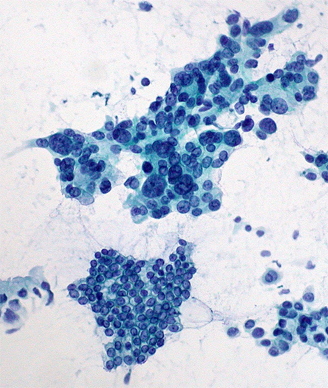ASCO GI: Immunotherapies Boost Survival in Pancreatic Cancer
The combination of two anticancer vaccines demonstrated improved survival compared to a single vaccine in patients with advanced pancreatic cancer, a particularly difficult to treat tumor type with few therapy options.
Pancreas FNA; adenocarcinoma (top) vs normal ductal epithelium (bottom); source: Ed Uthman, MD

The combination of two anticancer vaccines demonstrated improved survival compared with a single vaccine in patients with advanced pancreatic cancer, a particularly difficult to treat tumor type with few therapy options. Patients treated with a combination of two vaccines, GVAX pancreas and CRS-207, had a median overall survival of 6.1 months compared with 3.9 months in patients treated with GVAX alone (hazard ratio [HR] = 0.59; P = .012). This is the first randomized study that has shown immunotherapy to be effective for advanced pancreatic cancer, according to the study presenter, Dung T. Le, MD, professor of medicine at the Johns Hopkins University Sidney Kimmel Comprehensive Cancer Center in Baltimore, Maryland. The results of the randomized phase II trial were presented at the American Society of Clinical Oncology Gastrointestinal Cancers Symposium (ASCO GI).
“These are exciting results in a poor prognosis cancer,” said Smitha Krishnamurthi, MD, who specializes in gastrointestinal cancers at the University Hospitals Case Medical Center in Cleveland, Ohio, and moderated the press briefing. “This is a phase II study, but it's the first randomized study of immunotherapy in metastatic pancreatic demonstrating an improvement in survival.”
The combination of the two vaccines doubled the 1-year probability of survival from 12% in the GVAX alone arm to 24% in the GVAX plus CRS-207 vaccine arm.
The phase II open-label trial randomized 90 patients 2:1 with metastatic pancreatic ductal adenocarcinoma (who had either received first-line chemotherapy or refused the treatment) to either two doses of the GVAX vaccine followed by four doses of the CRS-207 vaccine or six doses of GVAX vaccine alone every 3 weeks. Fifty-one percent of the patients had received two or more previous chemotherapy regimens.
The trial was stopped early after the first interim analysis showed that the efficacy stopping point was attained. Patients in the GVAX monotherapy arm were then crossed over to receive the combination treatment.
The median overall survival for patients who received three or more doses of the combination vaccines was double that of the control arm (9.7 months vs 4.6 months; HR = 0.53, P = .02) per the protocol analysis. This analysis was part of the initial trial design. The study authors noted that the combination vaccine was effective in patients who had received two or more prior chemotherapy regimens. Median overall survival in these patients was 5.1 months compared with 3.7 months for the combination and GVAX alone arm, respectively (HR = 0.34, P = .001).
The combination therapies have so far been safe and well-tolerated, said Le during a press briefing. Side effects included local reactions to injection of GVAX, transient fevers, and lymphopenia after CRS-207 administration.
Advanced pancreatic cancer has a particularly poor prognosis. Patients typically survive for a median of 11 months once their cancer becomes metastatic. First-line standard of care is the FOLFIRINOX chemotherapy regimen. No standard second- or third-line treatments currently exist and patients who progress following first-line therapy typically survive 4 to 6 months.
Specific types of immunotherapies, including checkpoint immune blockade antibodies, have been shown to be efficacious in tumor types such as melanoma and kidney cancer, but vaccines alone have not made much headway in the clinic thus far. The current study tested a combination of two vaccines. GVAX pancreas is an irradiated, whole-cell tumor vaccine containing pancreatic cancer cells from a pancreatic cancer cell line modified to express the GM-CSF protein, a broad immune-stimulator. The vaccine is administered intradermally following a dose of cyclophosphamide, which inhibits regulatory T cells that act to dampen the immune response. The second vaccine, CRS-207, is live-attenuated Listeriamonocytogenes, which expresses mesothelin and stimulates both the innate and adaptive immune system against the mesothelin protein, present at high levels in pancreatic cancer cells. This combination should elicit first a broad antitumor immune system response to various tumor proteins, and is then thought to increase the immune response specifically against the mesothelin protein. This combination was shown to be synergistic in mouse tumor models, and in a phase I trial three advanced pancreatic cancer patients who had previously been treated with GVAX alone lived more than 15 months.
The efficacy of GVAX plus CRS-207 compared with both GVAX alone and chemotherapy will next be tested in the three-arm phase II randomized ECLIPSE trial, which plans to enroll approximately 240 previously treated metastatic pancreatic cancer patients.